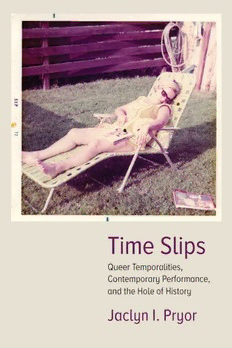
Time Slips: Queer Temporalities, Contemporary Performance, and the Hole of History PDF
Preview Time Slips: Queer Temporalities, Contemporary Performance, and the Hole of History
Time Slips SERIES EDITORS This series publishes books in theater and performance studies, Patrick Anderson and focused in particular on the material conditions in which Nicholas Ridout performance acts are staged, and to which performance itself might contribute. We define “performance” in the broadest sense, including traditional theatrical productions and performance art, but also cultural ritual, political demonstration, social practice, and other forms of interpersonal, social, and political interaction which may fruitfully be understood in terms of performance. Time Slips Queer Temporalities, Contemporary Performance, and the Hole of History Jaclyn I. Pryor northwestern university press evanston, illinois Northwestern University Press www.nupress.northwestern.edu Copyright © 2017 by Northwestern University Press. Published 2017. All rights reserved. Printed in the United States of America 10 9 8 7 6 5 4 3 2 1 Library of Congress Cataloging- in- Publication Data Names: Pryor, Jaclyn I., author. Title: Time slips : queer temporalities, contemporary performance, and the hole of history / Jaclyn I. Pryor. Description: Evanston, Illinois : Northwestern University Press, 2017. | Series: Performance works | Includes bibliographical references and index. Identifiers: LCCN 2017003470 | ISBN 9780810135314 (cloth : alk. paper) | ISBN 9780810135307 (pbk. : alk. paper) | ISBN 9780810135321 (e-book) Subjects: LCSH: American drama—21st century—History and criticism. | Performing arts—Social aspects—United States. | Group identity in the performing arts—United States. | Psychic trauma in the theater—United States. | United States—Historiography—Case studies. Classification: LCC PN1590.S6 P79 2017 | DDC 306.48480973—dc23 LC record available at https://lccn.loc.gov/2017003470 For Rebecca— With nothing on my tongue but Hallelujah My brother and I were at Sinai He kept a journal of what he saw of what he heard of what it all meant to him I wish I had such a record of what happened to me there It seems like every time I want to write I can’t I’m always holding a baby one of my own or one for a friend Always holding a baby so my hands are never free to write things down And then As time passes The particulars The hard data The who what when where why Slip away from me And all I’m left with is The feeling But feelings are just sounds The vowel barking of a mute My brother is so sure of what he heard After all he’s got a record of it Consonant after consonant after consonant If we remembered together We could recreate holy time Sparks flying — Merle Feld, “We All Stood Together” Contents Preface ix Acknowledgments xiii Introduction 3 Chapter 1. No Rock Straight Time Rain or Shine: Carlson/Strom Remember the Geyserlands 41 Chapter 2. When Elephants Are in Must: Peggy Shaw, Acts of Trans/fer, and the Present Future of Queer 67 Chapter 3. Following the Ghosts: Repetition, Return, and the Disordering of America in floodlines (2004– 2010) 89 Chapter 4. Teaching Time (a periplum) 125 Epilogue. I Want to Play Airplane, or, It All Comes Back 147 Notes 153 Bibliography 169 Index 179 Preface Perhaps, says Derrida, Freud’s contribution to any theory of the archive is that there isn’t one: that no storehouse, especially not the psychoanalytic archive of the human psyche, holds the records of an original experience, to which we may return. Yet psychoanalysis has been responsible for some of this trouble with archives, for it wants to get back: it manifests a desire for origins, to find the place where things started, before the regime of repetition and representation was inaugurated. — Carolyn Steedman, Dust: The Archive and Cultural History On my desk, stuck to a plastic file folder that holds the paper contents of the outline of what would eventually become this book, is a small yellow Post- it note. “NEVER FORGET,” it says. I wrote it at night. And it’s a good thing, because by morning, I already had. My friend Nicole had had me over for dinner to help me map out what was then a nascent idea for a dissertation, because, as I put it, I was desperate. And I was, and we did. And she took notes, copious ones, so that I wouldn’t forget, so that I wouldn’t lose it all as time slipped by. “What if I forget how it all fits together?” I panicked as I was leaving. “Will you be my witness? Will you remember for me? Can you remind me?” She sealed our notes in plastic, because of the rain, and because perhaps, too, plastic— unlike memory— is the one thing that will surely, sadly, never decompose. As I was falling asleep, I remembered one more important piece that hadn’t made it into the official archive of our conversation. I didn’t want to lose it. I grabbed a pen and Post- it, wrote “NEVER FORGET,” stuck it to the folder, and went to bed. “Never Forget” was the unofficial slogan for Holocaust memorializa- tion in the 1980s, or at least it was in my neighborhood. Skokie, Illinois, was then teeming with survivors, and so, too, with public discourse about the Holocaust. Across the street from my childhood home was an Iranian synagogue (still is), with a large, metal “Never Forget” sign staked on its front lawn. Or maybe it said “Never Forget 6,000,000,” I can’t remember. We didn’t “belong” to that synagogue (they were Orthodox, we were not; they were Iranian, we were not), but I passed it every day on my way to school. And although the word “Holocaust” was nowhere, and although I was a kid, I somehow understood its referent and knew that it had something ix
